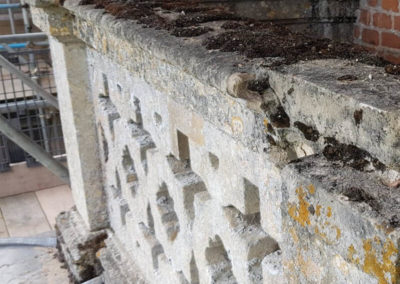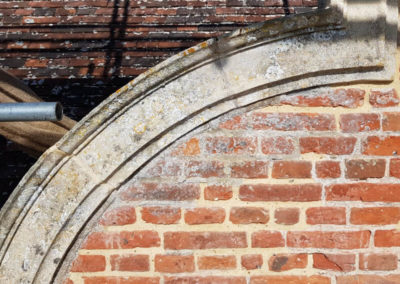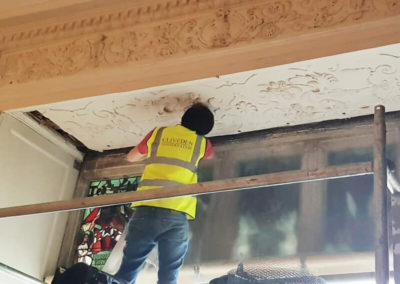Project overview
Project overview
Blickling Hall is an imposing 17th century Jacobean stately home in the custody of the National Trust. A substantial programme of conservation has been undertaken to redress the deleterious effect of deathwatch beetle on the building’s internal fabric, as well as restoring areas of the facade. Cliveden Conservation were chosen to deliver a range of specialist solutions, including stabilising the historic lath and plaster ceilings in the North West turret, restoration of brick pointing on the eastern gables, balustrade restoration, and refixing and conserving the roof statuettes.
Summary of the conservation work carried out
Prior to stabilising the decorative plaster ceiling from above, conservators propped the ceiling from below using a cushion of lamb’s wool and foam sheets to protect the delicate embellishments. Work from above then consisted of incorporating stainless steel hangers into the lathwork, fixed to the joists and tied to the lathe and plaster by a dovetailed channel of epoxy resin.
A key benefit of this discrete method was that it enabled the main contractor to access and tie into the timber joists without obstruction. As an ancillary benefit for the client, a number of historic musket balls were discovered during preparation that had been sitting beneath the floorboards for well over 150 years!
Additional plaster repair and stabilisation work was carried out on a decorated soffit in the hall’s grand library, requiring the taking of a mould in order to be able to restore the incomplete motif.
Externally, pointing to the gables had become friable in places and elsewhere there had been inappropriate historic repairs using portland cement. Trials for mortar content and colour matching were undertaken by Cliveden Conservation. A hotlime mortar was suggested which would be better suited to the soft red bricks and visually in keeping with the surrounding fabric.
Restoring the section of balustrade required carefully excising the existing unit – a piecemeal historic repair that did not fit and was liberally bonded with resin – and replacing it with a hand worked block of ketton, sourced to match the surrounding masonry and weather in over time.
The stone statuettes adorning the eastern gables had been subject to various degrees of erosion through weathering. Most were carefully hand-cleaned in situ before a sheltercoat was applied to consolidate and protect them. Movement of the underlying keystones had created a potentially unsafe tilt to two statues, therefore conservators safely removed these to be conserved offsite whilst their masons refitted the keystones – updating them with a stainless steel fixing whilst replacing and maintaining the original seashells found in the jointing.
Results
The outcome of this project extends the life of the building for the enjoyment of visitors whilst retaining and preserving as much of the building’s original material as possible. For Cliveden Conservation’s conservators the project provided interesting insights into the hall’s construction as well as the opportunity to bring to bear a variety of skills and knowledge.
Project details
Client:
The National Trust, Blickling Hall, Aylsham, Norfolk
Principal Conservation Contractor:
Cliveden Conservation
Category:



